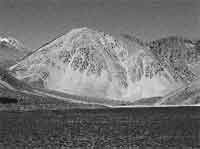With warm regrets
 global warming is set to make a horrifying mark on the high altitudes. While climate changes are taking a toll on the giant glaciers on the Himalaya by melting them, they are threatening the lives of thousands of native people and a host of rare animal species.
global warming is set to make a horrifying mark on the high altitudes. While climate changes are taking a toll on the giant glaciers on the Himalaya by melting them, they are threatening the lives of thousands of native people and a host of rare animal species.
The melting glaciers form natural lakes whose sudden rupturing is a cause of great concern. According to reports, the glaciers are retreating. As the ice melts, lakes are formed between the mounds of debris and rocks that are left behind by the sliding glaciers. These lakes are characterised by an imbalanced inflow-outflow. This implies that the glacial lakes are fed with water from the melting ice at a rate faster than the rate at which it can be drained, thus making glacier lake outburst floods ( glof s) more frequent.
The impact of such outbursts is massive. The 1981 flood from Zhangzanbo lake in Tibet destroyed infrastructure at Sun Koshi Hydro Project and the damages were to the tune of us $3 million. Similarly, the 1985 Dig Tsho lake outburst swept away the us $1.5 m Namche Hydro-electric Project.
Experts predict that the Imja glacier lake in Sagarmatha National Park, Nepal, will burst in the next five to six years. Should this happen, snow leopards, Himalayan tahr, and musk deer are just a few of the species whose survival would be endangered. The Imja lake that started forming in the 1960s currently holds about 28 million cubic metres of water. As declared by Mingma Norbu Sherpa, the World Wide Fund for Nature ( wwf ) representative in Nepal, "the Sagarmatha National Park, with more than 3,000 residents and another 50,000 living downstream, are sitting atop a climate-induced time bomb.'
Most of Nepal's active glaciers are in the east. Of the six major glacial outburst sites in Nepal, two are in Sagarmatha National Park, which is close to Mount Everest. The region is known for popular tourist and mountaineering destinations and also for its spectacular wildlife and terrain. The region is inhabited mostly by the Sherpas, who make a living by trading, farming potatoes, and raising yak herds. Younger people from the tribe work as mountaineers, porters, and trekking guides. Any glacial lake outburst would spell disaster for the community. This is true for the whole of Nepal as the economy of the cash-strapped country depends heavily on seasonal earnings from mountaineering and trekking, which are greatly affected during floods.
One of the main reasons for global warming is the emission of greenhouse gases such as carbon dioxide from the burning of coal and oil. It is expected to lead to unprecedented climate changes. The 1995 report of the Intergovernmental Panel on Climate Change
